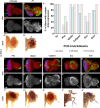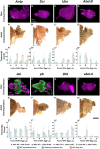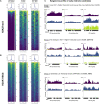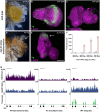Polycomb safeguards imaginal disc specification through control of the Vestigial-Scalloped complex
- PMID: 37702007
- PMCID: PMC10560572
- DOI: 10.1242/dev.201872
Polycomb safeguards imaginal disc specification through control of the Vestigial-Scalloped complex
Abstract
A fundamental goal of developmental biology is to understand how cell and tissue fates are specified. The imaginal discs of Drosophila are excellent model systems for addressing this paradigm as their fate can be redirected when discs regenerate after injury or when key selector genes are misregulated. Here, we show that when Polycomb expression is reduced, the wing selector gene vestigial is ectopically activated. This leads to the inappropriate formation of the Vestigial-Scalloped complex, which forces the eye to transform into a wing. We further demonstrate that disrupting this complex does not simply block wing formation or restore eye development. Instead, immunohistochemistry and high-throughput genomic analysis show that the eye-antennal disc unexpectedly undergoes hyperplastic growth with multiple domains being organized into other imaginal discs and tissues. These findings provide insight into the complex developmental landscape that tissues must navigate before adopting their final fate.
Keywords: Drosophila; Epigenetics; Eye; Imaginal disc; Polycomb; Scalloped; Vestigial; Wing.
© 2023. Published by The Company of Biologists Ltd.
Conflict of interest statement
Competing interests The authors declare no competing or financial interests.
Figures








Update of
-
Polycomb safeguards imaginal disc specification through control of the Vestigial-Scalloped complex.bioRxiv [Preprint]. 2023 Apr 12:2023.04.11.536444. doi: 10.1101/2023.04.11.536444. bioRxiv. 2023. Update in: Development. 2023 Sep 15;150(18):dev201872. doi: 10.1242/dev.201872. PMID: 37090526 Free PMC article. Updated. Preprint.
Similar articles
-
Differential regulation of eye specification in Drosophila by Polycomb Group epigenetic repressors.Development. 2025 Jul 15;152(14):dev204317. doi: 10.1242/dev.204317. Epub 2025 Jul 29. Development. 2025. PMID: 40621729
-
Polycomb safeguards imaginal disc specification through control of the Vestigial-Scalloped complex.bioRxiv [Preprint]. 2023 Apr 12:2023.04.11.536444. doi: 10.1101/2023.04.11.536444. bioRxiv. 2023. Update in: Development. 2023 Sep 15;150(18):dev201872. doi: 10.1242/dev.201872. PMID: 37090526 Free PMC article. Updated. Preprint.
-
scalloped functions in a regulatory loop with vestigial and wingless to pattern the Drosophila wing.Dev Genes Evol. 1999 Jan;209(1):10-7. doi: 10.1007/s004270050222. Dev Genes Evol. 1999. PMID: 9914414
-
Large-scale imaginal disc sorting: A protocol for "omics"-approaches.Methods. 2014 Jun 15;68(1):260-4. doi: 10.1016/j.ymeth.2014.04.005. Epub 2014 Apr 13. Methods. 2014. PMID: 24736056 Review.
-
Regeneration and transdetermination in Drosophila imaginal discs.Annu Rev Genet. 2012;46:289-310. doi: 10.1146/annurev-genet-110711-155637. Epub 2012 Aug 29. Annu Rev Genet. 2012. PMID: 22934642 Review.
Cited by
-
Control of fate specification within the dorsal head of Drosophila melanogaster.Development. 2024 Aug 15;151(16):dev199885. doi: 10.1242/dev.199885. Epub 2024 Aug 27. Development. 2024. PMID: 39190554 Free PMC article.
-
Differential regulation of eye specification in Drosophila by Polycomb Group epigenetic repressors.Development. 2025 Jul 15;152(14):dev204317. doi: 10.1242/dev.204317. Epub 2025 Jul 29. Development. 2025. PMID: 40621729
References
-
- Al Hajri, Q., Dash, S., Feng, W.-C., Garner, H. R. and Anandakrishnan, R. (2020). Identifying multi-hit carcinogenic gene combinations: Scaling up a weighted set cover algorithm using compressed binary matrix representation on a GPU. Sci. Rep. 10, 2022. 10.1038/s41598-020-58785-y - DOI - PMC - PubMed
Publication types
MeSH terms
Substances
Grants and funding
LinkOut - more resources
Full Text Sources
Molecular Biology Databases

